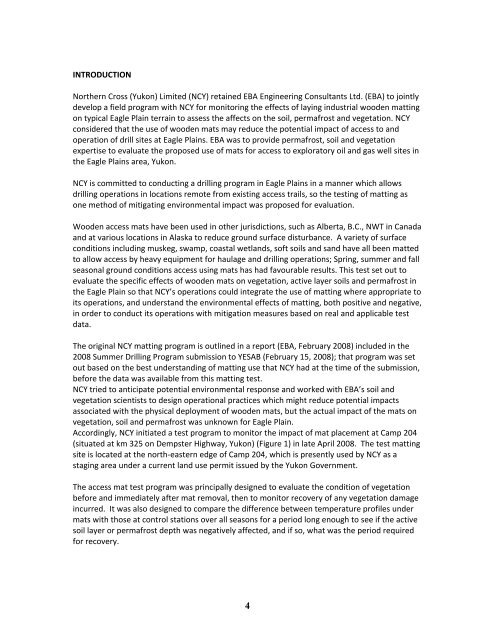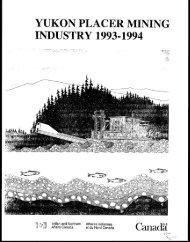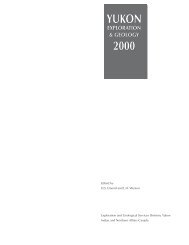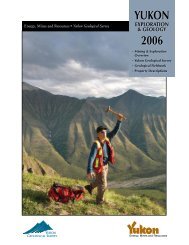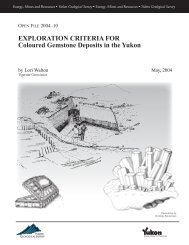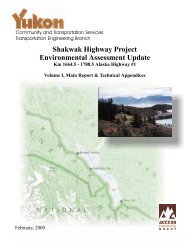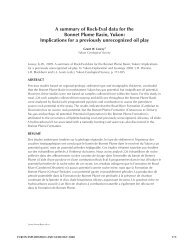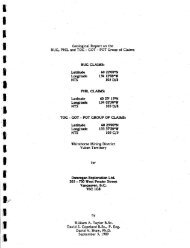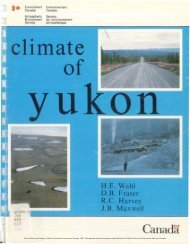Eagle_Plain_matting_..
Eagle_Plain_matting_..
Eagle_Plain_matting_..
Create successful ePaper yourself
Turn your PDF publications into a flip-book with our unique Google optimized e-Paper software.
INTRODUCTION<br />
Northern Cross (Yukon) Limited (NCY) retained EBA Engineering Consultants Ltd. (EBA) to jointly<br />
develop a field program with NCY for monitoring the effects of laying industrial wooden <strong>matting</strong><br />
on typical <strong>Eagle</strong> <strong>Plain</strong> terrain to assess the affects on the soil, permafrost and vegetation. NCY<br />
considered that the use of wooden mats may reduce the potential impact of access to and<br />
operation of drill sites at <strong>Eagle</strong> <strong>Plain</strong>s. EBA was to provide permafrost, soil and vegetation<br />
expertise to evaluate the proposed use of mats for access to exploratory oil and gas well sites in<br />
the <strong>Eagle</strong> <strong>Plain</strong>s area, Yukon.<br />
NCY is committed to conducting a drilling program in <strong>Eagle</strong> <strong>Plain</strong>s in a manner which allows<br />
drilling operations in locations remote from existing access trails, so the testing of <strong>matting</strong> as<br />
one method of mitigating environmental impact was proposed for evaluation.<br />
Wooden access mats have been used in other jurisdictions, such as Alberta, B.C., NWT in Canada<br />
and at various locations in Alaska to reduce ground surface disturbance. A variety of surface<br />
conditions including muskeg, swamp, coastal wetlands, soft soils and sand have all been matted<br />
to allow access by heavy equipment for haulage and drilling operations; Spring, summer and fall<br />
seasonal ground conditions access using mats has had favourable results. This test set out to<br />
evaluate the specific effects of wooden mats on vegetation, active layer soils and permafrost in<br />
the <strong>Eagle</strong> <strong>Plain</strong> so that NCY’s operations could integrate the use of <strong>matting</strong> where appropriate to<br />
its operations, and understand the environmental effects of <strong>matting</strong>, both positive and negative,<br />
in order to conduct its operations with mitigation measures based on real and applicable test<br />
data.<br />
The original NCY <strong>matting</strong> program is outlined in a report (EBA, February 2008) included in the<br />
2008 Summer Drilling Program submission to YESAB (February 15, 2008); that program was set<br />
out based on the best understanding of <strong>matting</strong> use that NCY had at the time of the submission,<br />
before the data was available from this <strong>matting</strong> test.<br />
NCY tried to anticipate potential environmental response and worked with EBA’s soil and<br />
vegetation scientists to design operational practices which might reduce potential impacts<br />
associated with the physical deployment of wooden mats, but the actual impact of the mats on<br />
vegetation, soil and permafrost was unknown for <strong>Eagle</strong> <strong>Plain</strong>.<br />
Accordingly, NCY initiated a test program to monitor the impact of mat placement at Camp 204<br />
(situated at km 325 on Dempster Highway, Yukon) (Figure 1) in late April 2008. The test <strong>matting</strong><br />
site is located at the north‐eastern edge of Camp 204, which is presently used by NCY as a<br />
staging area under a current land use permit issued by the Yukon Government.<br />
The access mat test program was principally designed to evaluate the condition of vegetation<br />
before and immediately after mat removal, then to monitor recovery of any vegetation damage<br />
incurred. It was also designed to compare the difference between temperature profiles under<br />
mats with those at control stations over all seasons for a period long enough to see if the active<br />
soil layer or permafrost depth was negatively affected, and if so, what was the period required<br />
for recovery.<br />
4


